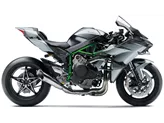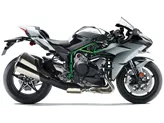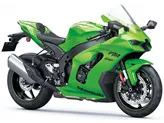Kawasaki Ninja H2 2015 vs. Yamaha R1 2015

Kawasaki Ninja H2 2015

Yamaha R1 2015
Overview - Kawasaki Ninja H2 2015 vs Yamaha R1 2015
The Kawasaki Ninja H2 model year 2015 and the Yamaha R1 model year 2015 are both high-performance supersport motorcycles that offer impressive power and performance. However, there are some key differences between the two bikes.
Starting with the engine and drive train, the Kawasaki Ninja H2 is equipped with a 998cc engine that produces 200 horsepower and 133.5 Nm of torque. It has a bore of 76 mm and a stroke of 55 mm, with a compression ratio of 8.5. The engine features four cylinders and four valves per cylinder, with a DOHC configuration. On the other hand, the Yamaha R1 also has a 998cc engine that produces 200 horsepower, but it has a lower torque output of 112.4 Nm. The R1 has a larger bore of 79 mm and a shorter stroke of 50.9 mm, resulting in a higher compression ratio of 13. Like the Ninja H2, the R1 also has four cylinders and four valves per cylinder with a DOHC configuration.

Kawasaki Ninja H2 2015
In terms of suspension, the Kawasaki Ninja H2 features a telescopic fork front suspension, while the Yamaha R1 is equipped with an upside-down telescopic fork front suspension. Both bikes have double disk front brakes and 17-inch front and rear tire diameters. The Ninja H2 has a front tire width of 120 mm and a rear tire width of 200 mm, while the R1 has a slightly narrower rear tire width of 190 mm. The Ninja H2 has a wheelbase of 1455 mm and a seat height of 825 mm, while the R1 has a slightly shorter wheelbase of 1405 mm and a taller seat height of 855 mm. The kerb weight of the Ninja H2 is 238 kg with ABS, while the R1 weighs 199 kg with ABS. Both bikes have a fuel tank capacity of 17 liters.
In terms of strengths, the Kawasaki Ninja H2 is known for its outstanding build quality and the fascinating engine with a mechanical turbocharger. It offers exceptional pull, acceleration, and speed, taking performance to a completely new level. The narrow seat ensures safe standing, even for smaller riders, and the bike offers great stability and inspires confidence despite its high performance. The Ninja H2 also has strong brakes and high-quality details.
On the other hand, the Yamaha R1 is praised for its crazy sound and rev-happy engine with a strong peak. It offers a great racing feeling in the saddle and comes with a superior electronics package. The R1 also boasts high-quality workmanship.

Yamaha R1 2015
However, both bikes have their weaknesses. The Kawasaki Ninja H2 has a response behavior in the transition from pushing mode to acceleration phase that is not at the level of "normal" motorcycles. It also experiences understeer in fast bends and may have integration issues for riders taller than 185 cm. On the other hand, the Yamaha R1 has torque sag in the middle and stability issues in the braking zone.
In conclusion, both the Kawasaki Ninja H2 2015 and the Yamaha R1 2015 are powerful and high-performance motorcycles with their own unique strengths and weaknesses. The Ninja H2 offers an exceptional engine with a mechanical turbocharger and great stability, while the R1 provides a thrilling racing experience and superior electronics. Ultimately, the choice between the two will depend on the rider's preferences and priorities.
Technical Specifications Kawasaki Ninja H2 2015 compared to Yamaha R1 2015
Pros and Cons in comparison
Pros and Cons in comparison
Kawasaki Ninja H2 2015

The Ninja H2 represents a milestone in motorbike history. It is not only packed with electronic innovations, but also offers completely new technologies in terms of engine construction and mechanics. This high-tech research object of a Japanese technology company is actually for sale and can also be ridden. Basically, it rides like a normal motorbike, only with considerably more power. At first, the engine response is a challenge, but speed freaks will find a way to ride and enjoy this fascinating motorbike.
Yamaha R1 2015

The new R1 is a big hit and no longer compares to the previous model. This was considered a good country road bike and heavy investments had to be made for excursions to the race track. Now it is the other way round. The new R1 has been developed with a clear focus on the race track. The electronics package seems outstanding, technology freaks will get their money's worth. Yamaha fans have to buy it, they finally have a worthy motorbike. The R1 has slight weaknesses when braking - it becomes a little unstable here. If you want to buy a ready-made racing bike without having to work on the chassis, you'd better go for the R1M. The Öhlins electronic suspension works perfectly and has no weaknesses. For pure racetrack use, the second weakness of the R1 can easily be ironed out. The torque hole in the middle can be easily ironed out with a new mapping.
Price Comparison Avarage Market Price Kawasaki Ninja H2 vs Yamaha R1
There are a few key differences between a Kawasaki Ninja H2 2015 and a Yamaha R1 2015. There are the same number of bikes of both models available on the 1000PS.de marketplace, specifically 4. It takes less time to sell a Yamaha R1 with 76 days compared to 153 days for the Kawasaki Ninja H2. Since model year 2015 1000PS.de editors have written 27 reviews for the Kawasaki Ninja H2 and 80 reviews for the Yamaha R1 since model year 2005. The first review for the Kawasaki Ninja H2 was published on 31/08/2014 and now has more than 5,600 views. This compares to more than 3,900 views for the first review on Yamaha R1 published on 28/04/2003.



















